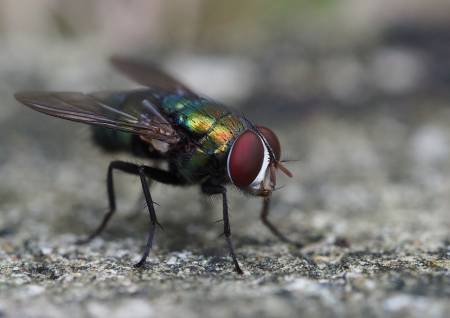


There are more than 150 species of flies in Singapore. They all belong to the order Diptera, meaning they have two wings. Because they only have two wings, flies land often and hence can deposit thousands of bacteria every time they land.
Our Greencare technician is trained to help manage flies and similar pests. Since every building or home is different, our Greencare technician will design a unique pest control program for your situation.
Our Greencare technician can provide the right solution to keep flies in their place…out of your home, or workplace.
One pair of flies can reproduce more than 1 million offsprings through their offsprings’ offsprings in just a matter of weeks.
There are many different ways homeowners may get a fly in their living space. The insects can enter houses on food products (fruit flies) or drift in through open windows and doors. They may also be attracted to and develop in decaying organic matter in drains. They can also infest dead animals in walls, attics, or other hidden places inside the home. Some species prefer to overwinter inside and are attracted to sunny parts of the home and upper floors of buildings.
Because people correctly associate flies with filth, these pests disgust and annoy residents in homes. The insects can also transfer disease organisms when they touch food and kitchen surfaces. In addition, certain fly species can inflict painful bites on humans and animals. The U.S. Department of Agriculture sources reveal that flies contaminate or destroy $10 billion worth of agricultural products annually.
Disease
Millions of microorganisms may flourish in a single fly’s gut, while a half-billion more swarm over its body and legs. Flies spread diseases readily because they move quickly from rotting, disease-laden garbage to exposed human foods and utensils. Every time a fly lands, it sloughs off thousands of microbes which can cause serious illnesses like:
More than 100 pathogens are associated with the house fly, including Salmonella, Staphylococcus, E. coli, and Shigella. These pathogens can cause disease in humans and animals. Some of the diseases include:
The best way to repel flies is through simple, preventive measures. In order to best repel flies, limit access to your home as much as possible, keeping doors and windows closed. You may also choose to screen windows, doors, and vents. Keep garbage cans clean and securely closed. Keeping surfaces clean will make your home less appealing to flies. For best results, contact a pest control professional to discuss extermination options.
Where Do They Live?
Flies plague every part of the world except the polar ice caps. Flies prefer warm temperatures and are most active from late spring to early autumn.
What Do They Eat?
When flies feed on waste, they collect pathogens on their legs and mouths. These pathogens are then transferred to food on tables or counters when a fly lands again. Flies regurgitate on solid food then they eat the liquid. They are capable of transmitting disease when they vomit, groom themselves, or just walk on surfaces.
The development of flies involves a four-phase life cycle. Beginning as eggs, flies undergo larval and pupal stages before emerging as adults. Depending on the species, the life expectancy of a fly is eight days to two months or, in some cases, up to a year.
One pair of flies can produce more than 1 million offspring through their offsprings’ offspring in a matter of weeks.
Eggs
The fly’s life cycle begins when a fertilized female finds a suitable location for laying her eggs. The ideal egg site is material that the larvae will eat when they hatch from the egg. Examples of egg-laying sites might include a pile of trash, feces or other damp, decomposing organic material. In some cases, fertilized eggs hatch within 24 hours.
Larvae
Upon hatching, larvae feed upon the organic material. Fly larvae eat for several days to weeks, storing enough protein and nutrients to last through their upcoming pupa stage.
Pupal
When larvae are grown, they leave their food source and seek dry, dark places within which to pupate. During the pupal stage, flies develop from legless larvae into adults with six legs, compound eyes, and a pair of wings.
Adult
Development time from egg to adult varies depending on species, environmental conditions, and abundance of food. Some flies can complete their development in a matter of a couple of weeks if conditions are right.
If you cannot find the answer to your question in our FAQs, you can always Contact Us . We will answer you shortly!